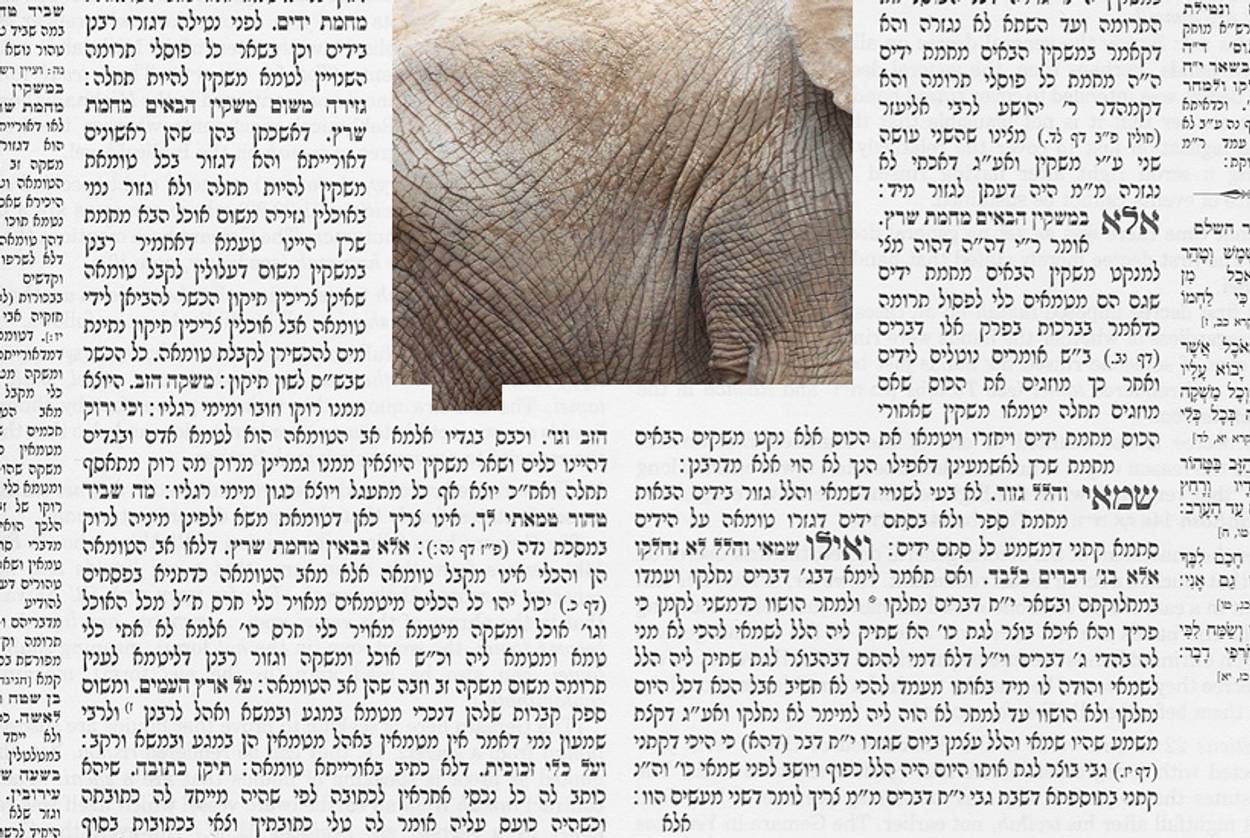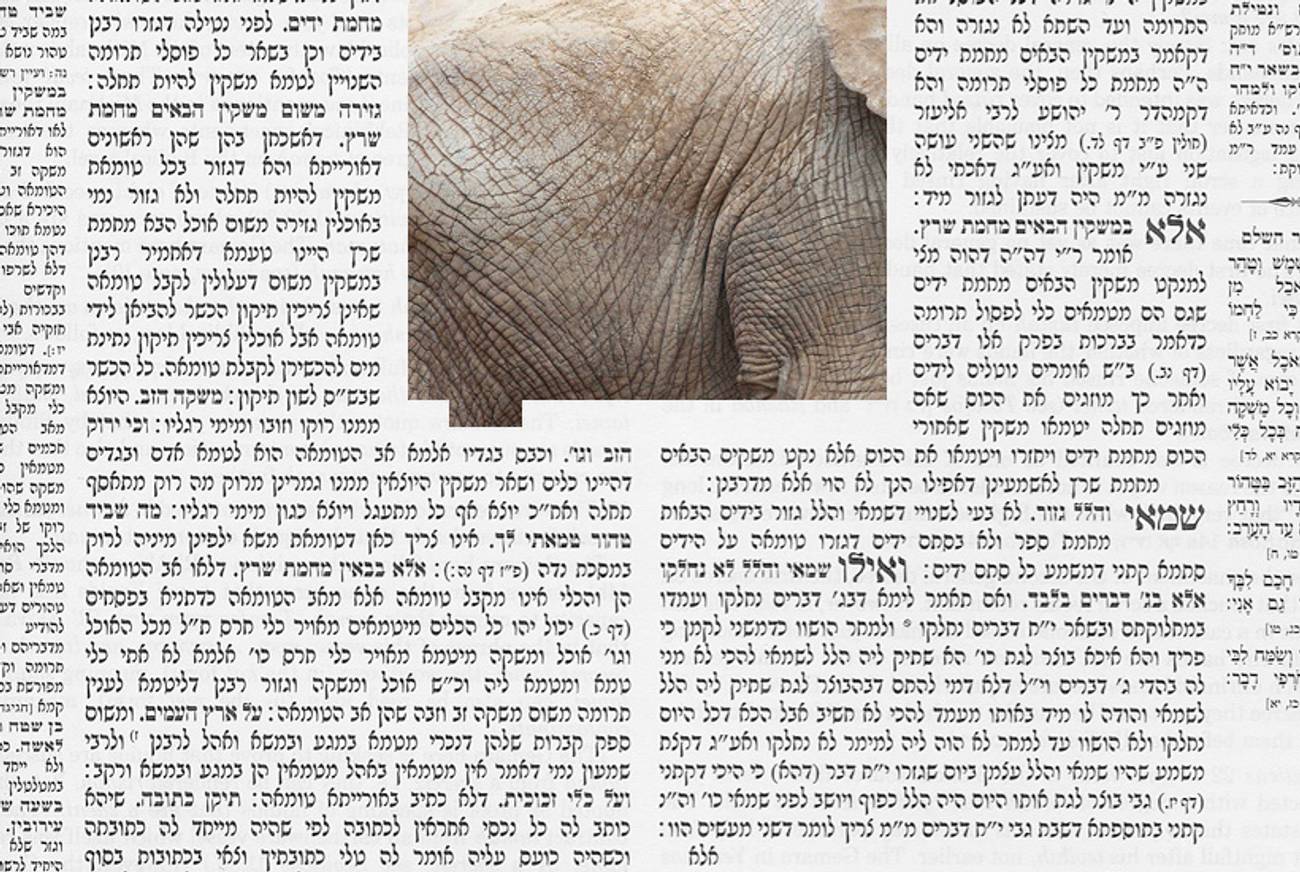Rationalism, Mysticism, Slaves, and a Sukkah Made From an Elephant
The Talmud describes rabbis who were not just judges and legal analysts, but magicians as well




Literary criticAdam Kirschis readinga page of Talmud a day, along with Jews around the world.
Almost every individual named in the Talmud is a rabbi, which is why the few exceptions—the non-rabbinic characters in the text—are so intriguing. This is not to say that the rabbis are all the same: Many of them are vivid and distinct personalities, from Hillel the poor, Torah-loving convert to the rich and kingly Yehuda HaNasi. But they all stand in the same basic relationship to the law; they are its authors and exemplars, never its critics. “Hillel the Elder had 80 students,” we read in this week’s Daf Yomi reading, in Sukka 28a. “Thirty of them were worthy that the Divine Presence should rest upon them, as it did upon Moses our Teacher, and 30 of them were worthy that the sun should stand still for them, as it did for Joshua bin Nun, and 20 were intermediate between the other two.”
This image presents the rabbis in a kind of holy rivalry, with some closer to perfection than others, but all in pursuit of the same scholarly and spiritual ideal. Yochanan ben Zakkai is famous as the rabbi primarily responsible for the survival of Judaism after the Roman conquest of 70 C.E. According to legend, he had himself smuggled out of the besieged city disguised as a corpse and then begged the Emperor Vespasian for permission to establish an academy at Yavneh, where the foundations of rabbinic Judaism were laid. According to the Talmud, the great Yochanan was merely the youngest and least accomplished of Hillel’s students, but even he was capable of understanding “conversation of ministering angels, the conversation of demons, and the conversation of palm trees.” The eldest of Hillel’s disciples, Yonatan ben Uzziel, was so powerfully holy that “when he sat and engaged in Torah study, any bird that flew over him was immediately incinerated.”
How can the reader of the Talmud identify with such figures? They are too saintly for that; all we can do is revere them. But things are different with a character like Beruriah, the wife of Rabbi Meir, whom Beth Kissileff discussed in Tablet last week—or like Tavi, the slave of Rabban Gamliel, whom we met this week at the beginning of Chapter 2 of Tractate Sukka. These people are what academics sometimes call “subalterns,” occupying a lower rank in Jewish society than the rabbis, and their perspectives are especially hard to recover.
The story the Talmud tells about Tavi, for instance, is enigmatic. He was a Canaanite slave, which meant that according to Torah law he could never be set free. Yet as the notes to the Koren Talmud explain, he was renowned for his “propriety and erudition,” and Gamliel treated him as a family member, even accepting condolences when Tavi died. In Tractate Sukka, Tavi comes in to demonstrate a point of law having to do with the use of beds in a sukkah. Because you are required by law to sleep under the sukkah’s roof, it is forbidden to put another structure in between your body and the roof: For this reason, you cannot sleep underneath your bed in the sukkah. (Just why you would want to do this is unclear, but the Talmud spends a good deal of time on the matter: Perhaps in warm weather under the bed was the coolest place to be.)
This law applies only to Jews, of course; a Canaanite slave like Tavi was not obligated to follow the rules of Sukkot. Yet Tavi was learned enough in the Torah to know the rules he was not supposed to follow—Rabban Gamliel even calls him a “Torah scholar,” a talmid hakham—so he demonstratively slept under a bed in the sukkah. In doing so Tavi taught two laws by example: that a Jew cannot sleep under a bed in the sukkah, and that a Canaanite is not obligated to follow all the mitzvot binding on a Jew. There is a fascinating kind of ambiguity in this gesture of Tavi’s. He was simultaneously dramatizing that he was just like the rabbis, in his knowledge of law, and totally unlike them, because the law was not his. If you had to choose one person from the Talmud to bring back to life and interview, Tavi might not be the obvious choice, but he could be the most revealing witness to how the rabbis actually lived their Judaism.
In describing Yochanan ben Zakkai’s wisdom, this week’s Talmud reading also opened a door on the fascinatingly obscure world of Jewish mysticism. Yochanan, the Gemara says, knew about “a great matter and a small matter.” The small matter, it goes on to explain, was such things as “the disputes of Abaye and Rava”: that is, the kind of concrete disputes over the law that make up almost the entire text of the Talmud. The great matter, by contrast, is “the Design of the Chariot,” the Talmud’s name for a whole sphere of esoteric speculation about the nature of God and the universe, named after the bizarre vision of God’s chariot described by the prophet Ezekiel. This chariot mysticism, which Gershom Scholem elucidates in his classic study Major Trends in Jewish Mysticism, involved extremely detailed descriptions of God’s throne, his angels, his chariot and its wheels, all of which could be seen by the adept.
Yet if that kind of speculation is a great matter and the whole of Talmudic debate is a small matter, where does that leave the Talmud itself? After all, mysticism plays next to no part in the Talmud’s conception of Judaism. At most, mystical ideas come up in very oblique hints and references, as when we read that the Torah was written in white fire on black fire, or when we hear about the supernatural powers granted to Rabbi Simeon ben Yochai after his years of studying Torah in a cave. It would take later writers, especially the authors of the Zohar—a book written in 13th-century Spain but attributed to Simeon ben Yochai—to produce a kind of mystical scripture to complement the Talmud’s laws. But a hint like the one about Yochanan’s powers—he could apparently talk to angels and demons—leads one to suspect that the rabbis were not just judges and legal analysts, but magicians as well. This puts them in a fascinating new light, even as it seems to undercut the Talmud’s own rationalism.
Far different is the spirit of the rest of this week’s Daf Yomi reading, which confines itself to practical questions about Sukkot observance. Some of these are straightforward: To fulfill the commandment to “reside” in the sukkah, we learn, you must eat two meals a day in it. If necessary, a sukkah can be built on a ship, if you find yourself traveling on the holiday. But one of the rabbis’ debates stands out for its oddity. Can one of the walls of a sukkah, they ask, be an animal? Could you attach the roof of the sukkah to the side of an elephant and use the elephant’s bulk as a wall? It is hard to believe that anyone would actually try to do this, but the possibility excites the rabbis’ legal imagination, since it allows them to speculate about what exactly constitutes a wall.
Rabbi Yehuda says that you can use an elephant this way, while Meir says you can’t, on the grounds that your sukkah might get up and walk away. In the Gemara, Zeira suggests that you could always tie the elephant down, to make escape impossible; and with “a tied elephant, everyone agrees that a sukkah is fit.” Even if your elephant dies in the middle of the holiday, you could continue to prop up its corpse and it would be a valid wall, since “its carcass still has a height of 10 handbreadths.” The vision of Jews celebrating Sukkot in the shade of a rotting elephant carcass is absolutely surreal, but a tolerance for the bizarre is one of the distinctive features of Talmudic reasoning. As long as the principle is established, it doesn’t matter how odd the examples might be.
***
To read Tablet’s complete archive of Daf Yomi Talmud study,click here.
Adam Kirsch is a poet and literary critic, whose books include The People and the Books: 18 Classics of Jewish Literature.
Adam Kirsch is a poet and literary critic, whose books include The People and the Books: 18 Classics of Jewish Literature.